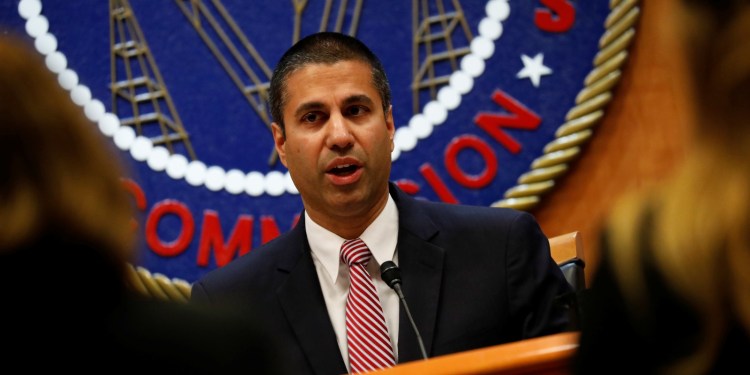Most of the scientific community has already concluded that the latest generation of cellular technology, 5G, is at least as safe to human health as the 2G, 3G, and 4G technologies that became globally ubiquitous over the past two decades. But once radio emissions safety questions were raised in the United States, the Federal Communications Commission took another look at the evidence. After an extended review, the agency has just given 5G a fairly definitive thumbs up for safety, though even this high level of reassurance is unlikely to stop conspiracy theorists from suggesting otherwise.
On paper, the FCC’s findings stop short of explicitly declaring any cellular technology trouble-free, but if you parse the legalese, that conclusion is hard to ignore. As Commission Chairman Ajit Pai explains, the FCC will “continue to ensure the health and safety of workers and consumers of wireless technology” by “maintain[ing] the Commission’s existing radiofrequency (RF) exposure limits,” which “for handheld devices are among the most stringent in the world.” Put more simply, the FCC says your existing cellular phone is already operating within strict, safe limits, and as the 5G era dawns, there’s no need to reduce radio signal strength further.
Pai is also proposing that the FCC do away with service- or technology-specific rules, and instead establish broad guidelines so that new devices can comply more uniformly with radio emission limits. In other words, rather than acting like 5G is somehow markedly different from 3G or 4G, or triggering a new outcry whenever 6G or other wireless standards are launched, the FCC wants rules that treat all radio-based devices the same.
To underscore its belief in cellular safety, the FCC notes that its radio emissions standards were developed in close consultation with other federal agencies, including the radiological health side of the Food and Drug Administration, which stated that the “available scientific evidence to date does not support adverse health effects in humans due to exposures at or under the current limits.” That means the top minds representing the federal government of one of the world’s most advanced countries are in agreement: Don’t worry about cellular exposure.
June 5th: The AI Audit in NYC
Join us next week in NYC to engage with top executive leaders, delving into strategies for auditing AI models to ensure fairness, optimal performance, and ethical compliance across diverse organizations. Secure your attendance for this exclusive invite-only event.
Unfortunately, I doubt that those conclusions will be enough to put the issue to rest. At the same time as it offered those assurances, the FCC said that it plans to seek public comments on “a rule to formalize the Commission’s existing methods of determining compliance with the RF exposure standard for devices operating at high frequencies.” Again decoded, that’s saying the FCC already has an unofficial way to approve high-frequency equipment — read: millimeter wave 5G devices — but for legal reasons, it needs to take public input into account before formalizing the compliance standards.
As much as I strongly believe in the value of public input into regulatory matters, the comment process has become at best a mess, if not an outright farce. Over the past two years, 5G has inspired pseudo-scientists, conspiracy theorists, and Russian disinformation trolls to target decent people looking to give greater meaning to their generalized fears about new technologies. It doesn’t take much effort to find people on the internet who are convinced the government is deliberately or negligently irradiating the population using radio towers.
Consequently, small anti-5G groups have popped up to protest radio towers that they think are poisoning people, birds, and bees. If this public comment period proceeds like past ones, the FCC will open its comment box to “listen” to them — and others who have their own reasons to oppose 5G, such as lobbying dollars or prior use of similar frequencies — then abruptly dismiss their concerns en masse before moving on to the next issue.
On the one hand, this is entirely understandable. If you believe most scientists and government officials, there’s no need to keep debating whether 5G is safe. Good science suggests that high-frequency millimeter waves are even less capable of penetrating the human body and supposedly causing cancer than the lower-frequency signals used in 2G, 3G, and 4G devices, which even after decades of skepticism have not been conclusively implicated as health risks. Asking for further public comment on this topic only gives fringe groups another chance to attract attention.
On the other hand, the comment process is there to give potentially meritorious claims an opportunity to be heard, so that important decisions aren’t made without considering whatever evidence members of the public want to bring to the discussion. As unlikely as it seems at this point that some big new discovery or development will change the FCC’s mind before it formalizes its high-frequency rules, it’s possible, and I suspect some people will take advantage of this possibly final opportunity to air their concerns.
So prepare yourself for one last gasp of anti-5G health agitation over the next few months. But don’t be surprised if the FCC listens politely, then — for better or worse — abruptly waves off the concerns before moving on to the next item on its agenda. The debate over whether 5G has negative health consequences might not be definitively settled, but once the FCC finishes its comment period, the discussion is going to move into the distant background, at least in the United States.

